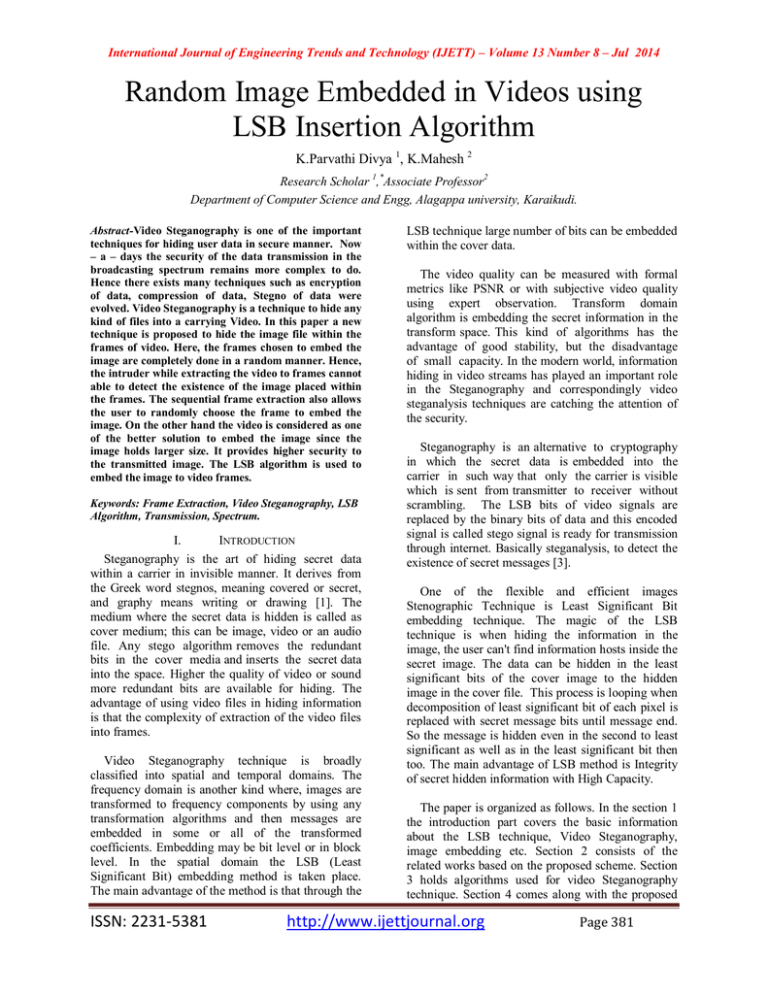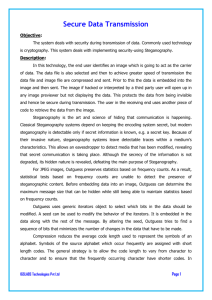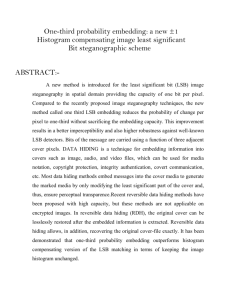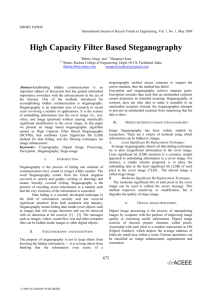Random Image Embedded in Videos using LSB Insertion Algorithm K.Parvathi Divya , K.Mahesh
advertisement

International Journal of Engineering Trends and Technology (IJETT) – Volume 13 Number 8 – Jul 2014 Random Image Embedded in Videos using LSB Insertion Algorithm K.Parvathi Divya 1, K.Mahesh 2 Research Scholar 1,*Associate Professor2 Department of Computer Science and Engg, Alagappa university, Karaikudi. Abstract-Video Steganography is one of the important techniques for hiding user data in secure manner. Now – a – days the security of the data transmission in the broadcasting spectrum remains more complex to do. Hence there exists many techniques such as encryption of data, compression of data, Stegno of data were evolved. Video Steganography is a technique to hide any kind of files into a carrying Video. In this paper a new technique is proposed to hide the image file within the frames of video. Here, the frames chosen to embed the image are completely done in a random manner. Hence, the intruder while extracting the video to frames cannot able to detect the existence of the image placed within the frames. The sequential frame extraction also allows the user to randomly choose the frame to embed the image. On the other hand the video is considered as one of the better solution to embed the image since the image holds larger size. It provides higher security to the transmitted image. The LSB algorithm is used to embed the image to video frames. Keywords: Frame Extraction, Video Steganography, LSB Algorithm, Transmission, Spectrum. I. INTRODUCTION Steganography is the art of hiding secret data within a carrier in invisible manner. It derives from the Greek word stegnos, meaning covered or secret, and graphy means writing or drawing [1]. The medium where the secret data is hidden is called as cover medium; this can be image, video or an audio file. Any stego algorithm removes the redundant bits in the cover media and inserts the secret data into the space. Higher the quality of video or sound more redundant bits are available for hiding. The advantage of using video files in hiding information is that the complexity of extraction of the video files into frames. Video Steganography technique is broadly classified into spatial and temporal domains. The frequency domain is another kind where, images are transformed to frequency components by using any transformation algorithms and then messages are embedded in some or all of the transformed coefficients. Embedding may be bit level or in block level. In the spatial domain the LSB (Least Significant Bit) embedding method is taken place. The main advantage of the method is that through the ISSN: 2231-5381 LSB technique large number of bits can be embedded within the cover data. The video quality can be measured with formal metrics like PSNR or with subjective video quality using expert observation. Transform domain algorithm is embedding the secret information in the transform space. This kind of algorithms has the advantage of good stability, but the disadvantage of small capacity. In the modern world, information hiding in video streams has played an important role in the Steganography and correspondingly video steganalysis techniques are catching the attention of the security. Steganography is an alternative to cryptography in which the secret data is embedded into the carrier in such way that only the carrier is visible which is sent from transmitter to receiver without scrambling. The LSB bits of video signals are replaced by the binary bits of data and this encoded signal is called stego signal is ready for transmission through internet. Basically steganalysis, to detect the existence of secret messages [3]. One of the flexible and efficient images Stenographic Technique is Least Significant Bit embedding technique. The magic of the LSB technique is when hiding the information in the image, the user can't find information hosts inside the secret image. The data can be hidden in the least significant bits of the cover image to the hidden image in the cover file. This process is looping when decomposition of least significant bit of each pixel is replaced with secret message bits until message end. So the message is hidden even in the second to least significant as well as in the least significant bit then too. The main advantage of LSB method is Integrity of secret hidden information with High Capacity. The paper is organized as follows. In the section 1 the introduction part covers the basic information about the LSB technique, Video Steganography, image embedding etc. Section 2 consists of the related works based on the proposed scheme. Section 3 holds algorithms used for video Steganography technique. Section 4 comes along with the proposed http://www.ijettjournal.org Page 381 International Journal of Engineering Trends and Technology (IJETT) – Volume 13 Number 8 – Jul 2014 algorithm procedure. Section 5 shows the experimental results obtained. Section 6 holds the conclusion for the proposed work. II. RELATED WORK Juan José Roque, Jesús María Minguet, propoes “SLSB: Improving the Steganographic Algorithm LSB”, a novel steganographic algorithm based on the spatial domain: Selected Least Significant Bits (SLSB). It works with the least significant bits of one of the pixel color components in the image and changes them according to the message’s bits to hide [4]. ShengDun Hu, KinTak U, each frame of both videos as the images and apply the image steganography for each frame with some necessary mechanism. Major condition of the algorithm is host video stream is F, hidden video stream is H. The frame length of the F is longer than or equal to that of H. Each frame of the secret video will be nonuniform rectangular partitioned and the partitioned codes obtained can be an encrypted version of the original frame. These codes will be hidden in the Least 4 Significant Bits of each frame of the host video [9]. Sherly A P and Amritha P P, Data hiding process are executed fully in the compressed domain. The algorithm works as data are embedded in the macro blocks of my frame with maximum scene change and in block of P and B frames with a maximum magnitude of motion vectors. To enlarge the capacity of the hidden secret information and to provide an imperceptible stego-image for human vision, a novel stegnographic approach called triway pixel-value differencing (TPVD) is constructed from all pixel pairs and embedded with secret data is generated [10]. Jafar Mansouri, Morteza Khademi, For each IVOP, the blocks with high spatial changes were selected and secret data were embedded in some AC coefficients. For P-VOP and B-VOP, secret bits were embedded in horizontal and vertical components of motion vectors with large magnitude which represented high temporal changes [3]. Swathi, S.A.K Jilani, Least significant bit (LSB) insertion is an important approach for embedding information in a carrier file. Least significant bit (LSB) insertion technique operates in LSB bits of the media file to hide the information bit. Proposed method, Data hiding scheme will be developed to hide the information in specific frames of the video and in the specific location of the frame by LSB substitution using polynomial equation. The key is ISSN: 2231-5381 used in the form of polynomial equations with different coefficients [8]. III. VIDEO STEGANOGRAPHY EXISTING TECHNIQUES The major work of video Steganography is hide secret message without affecting the visual quality, structure and content of the video file. Here following methods are achieved the above things. A. Video Steganography based on Non-uniform rectangular partition Non-uniform rectangular partition algorithm is used steganography in the uncompressed video. That means it try to hide a video stream in another video stream with almost the same size. Proposed work, each frame of both videos as the images and apply the image steganography for each frame with some necessary mechanism. Major condition of the algorithm is host video stream is F, hidden video stream is H. The frame length of F is longer than or equal to that of H. Each frame of the secret video will be Non-uniform rectangular partitioned and the partitioned codes obtained can be an encrypted version of the original frame. These codes will be hidden in the Least 4 Significant Bits of each frames of the host video [9]. B. Compressed Video Steganography using TPVD The proposed method data hiding process are executed fully in the compressed domain. Algorithm works as data are embedded in the macro blocks of I frame with maximum scene change and in block of P and B frames with maximum magnitude of motion vectors. To enlarge the capacity of the hidden secret information and to provide an imperceptible stego-image for human vision, a novel stegnographic approach called tri-way pixelvalue differencing (TPVD) is constructed from all pixel pairs and embedded with secret data is generated. Though decompression is not required. Proposed method provides high capacity and imperceptible stego-image for human vision of the hidden secret information [10]. C. An adaptive scheme for compressed video steganography Proposed method, for each I-VOP, the blocks with high spatial changes were selected and secret data were embedded in some AC coefficients. For P-VOP and B-VOP, secret bits were embedded in horizontal and vertical components of motion vectors with large magnitude which represented high temporal changes. The method did not require the original video signal or bit stream for data extraction. http://www.ijettjournal.org Page 382 International Journal of Engineering Trends and Technology (IJETT) – Volume 13 Number 8 – Jul 2014 The algorithm was performed for different bit rates and experimental results indicated that this algorithm had high visual quality and embedding capacity [3]. D. Video steganography by LSb substitution using different polynomial equations Least significant bit (LSB) insertion is an important approach for embedding information in a carrier file. Least significant bit (LSB) insertion technique operates on LSB bit of the media file to hide the information bit. Proposed method, Data hiding scheme will be developed to hide the information in specific frames of the video and in specific location of the frame by LSB substitution using polynomial equation. Here the information will be embedded based on the stego key. Key is used in the form of polynomial equations with different coefficients. By using this capacity of embedding bits into the cover image can be increased [8]. E. Video stegnography using 32 *32 vector quantization of DCT The proposed method of video stegnography which has been achieved with 32*32 vector quantization of DCT. Proposed work first of all the video has been sliced into different number of images. Then all the sliced images are passed to the 32*32 pixel management procedure followed by the LSB quantization method thorough which we find the vacant spaces of the images. The text message to be embedded is converted to the ascii encoded bits to make it compatible according to the vector table of the current segment of the video. The idea is to fill those bits first which occupy low intensity and if still there are bits left to be embedded then it to be embedded into high intensity bits .The scheme of embedding bits are finally performed by IDCT [7]. F. A high capacity video steganography based on integer wavelet transform The proposed system utilizes Integer wavelet transformation in cover image so as to get the stego-image. The capacity of the proposed algorithm is increased as the only approximation band of secret image is considered. The extraction model is actually the reverse process of the embedding model. Experimental results show that proposed method gets stego-image with high capacity and security with certain robustness. Integer wavelet transforms are used to exploit the spatial and temporal correlation in and between the video frames or minimizing the embedding distortion. Another achievement of a wavelet basis is that it supports multi resolution [6]. ISSN: 2231-5381 IV. PROPOSED METHODOLOGY In video stenography lots of techniques are available. All the existing technique does not support user interaction. The user does not know the process going on behind the screen. And also the existing algorithm video quality is not good after encryption. But in our proposed system supports user interaction and after encryption video quality does not change. Video Steganography embedded process using the least significant bits. A. Algorithm for Encoding Step 1: Read the input video where Steganography is processed in this video. V= input video. Step 2: Extract the image from the input video. Im = V (F1), V (F2), V(F2), V(F3), V(F4)…… V (Fn) Step 3: Get input from the user in which frame user desires to perform stegnography. That input value considers as a public key. Im = V(Fi), // F = user defined frame. Step 4: Find the least significant bit of the each pixel. Step 5: Read the secret image. Step 6: Replace the LSB value and substitute the secret image pixel in to Im . Step 7: Repeat the Step 6 until the last pixel in the secret image to be hidden. Step 8: Regenerate all the images into creating Stego video. B. Algorithm for Decoding. Step 1: Read the stego video. Step 2: authentication using public key of the receiver and know the value is called the stego frame. Step 3: Calculate LSB of each pixels of stego image. Step 4: Retrieve bits and convert each 8 bits into a character. Step 5:Get the Original video. http://www.ijettjournal.org Page 383 International Journal of Engineering Trends and Technology (IJETT) – Volume 13 Number 8 – Jul 2014 The block diagram architecture is given below: of the proposed Fig 5.2 Original Video Fig 5.3 Output Image Fig 4.1 Block Diagram of Proposed Architecture V. EXPERIMENTAL RESULTS The following section consists of the experimental results obtained from the proposed system. The input image is embedded within the frame, in the least significant bit value. Randomly the LSB changes according to the value found. Table 1 Cover video file information Name Resolution Viplane .mpg 160 x 120 Frame / Sec 15 Size (KB) 381 Fig 5.4 Stego Video Table 2 Capacity and PSNR values of stego frames Fig 5.1 Input Image ISSN: 2231-5381 Stego Frames PSNR Frame 1 65.1 Frame 2 66.9 Frame 3 65.9 http://www.ijettjournal.org Page 384 International Journal of Engineering Trends and Technology (IJETT) – Volume 13 Number 8 – Jul 2014 VI. CONCLUSION A new Video steganographic technique is proposed in the paper. They operate directly on the frames of the video and select the random frame to embed the image. The frame selection is the important criteria in the proposed structure. The image thus embedded using the LSB Algorithm, saves the efficiency of the video. Since, least significant bit is selected to hide the intruder is unaware of the data inside the video. This algorithm provides high capacity and imperceptible stego-image for human vision of the hidden secret information. The performance of the steganographic algorithm is studied and experimental results shows that this scheme can be applied on videos with no noticeable degradation in its quality. [10] Sherly A P and Amritha P P, "A Compressed Video Steganography using TPVD ",International Journal of Database Management Systems ( IJDMS ) Vol.2, No.3, August 2010. [11] Vivek Sampa,Kapil Dave,Jigar Madia,Parag Toprani, " A Novel Video Steganography Technique using Dynamic Cover Generation",National Conference on Advancement of Technologies – Information Systems & Computer Networks (ISCON – 2012).Proceedings published in International Journal of Computer Applications. REFERENCES [1] E. Cole and R.D. Krutz, Hiding in Plain Sight: Steganography and the Art of Covert Communication, Wiley Publishing, Inc., ISBN 0-471-44449-9, 2003. [2] EugeniyBelyaev et al., "Scalable Video Coding Based on Three Dimensional Discrete Pseudo Cosine Transform", ruSMART/NEW2AN 2010, LNCS 6294, pp 448-459, 2010. [3] Jafar Mansouri, Morteza Khademi,"An Adaptive Scheme for Compressed Video Steganography Using Temporal and Spatial Features of the Video Signal", 2009 Wiley Periodicals, Inc. [4] Juan José Roque, Jesús María Minguet, “SLSB: Improving the Steganographic Algorithm LSB “. [5] Kousik Dasgupta, J.K. Mandal, and Paramartha Dutta, “Hash Based Least Significant Bit Technique For Video Steganography(Hlsb) , in international Journal of Security, Privacy and Trust Management ( IJSPTM), Vol. 1, No 2, April 2012 . [6] Lakshmi narayanan K,Prabakaran G,Bhavani R, " A High Capacity Video Steganography Based on Integer Wavelet Transform", Journal of Computer Applications ISSN: 0974 – 1925, Volume-5, Issue EICA2012-4, February 10, 2012. [7] Prajna Vasudev,Kumar Saurabh ," VIDEO STEGNOGRAPHY USING 32 *32 VECTOR QUANTIZATION OF DCT", International Journal of Software & Hardware Research in Engineering Vol. 1 Issue. 3. [8] A. Swathi,S.A.K Jilani, " Video Steganography by LSB Substitution Using Different Polynomial Equations" , nternational Journal Of Computational Engineering Research (ijceronline.com) Vol. 2 Issue. 5. [9] ShengDun Hu, KinTak U," A Novel Video Steganography based on Non-uniform Rectangular Partition ",EE International Conference on Computational Science and Engineering. ISSN: 2231-5381 http://www.ijettjournal.org Page 385




